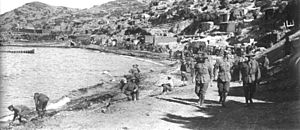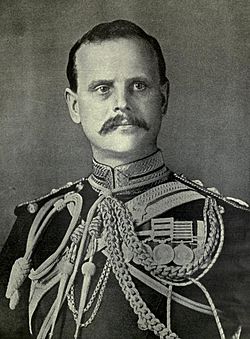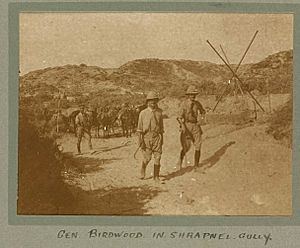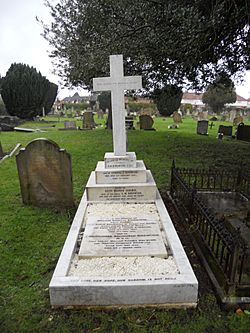William Birdwood facts for kids
Quick facts for kids
The Lord Birdwood
|
|
|---|---|

General Sir W. R. Birdwood by Elliott & Fry
|
|
| Nickname(s) | Birdy |
| Born | 13 September 1865 Kirkee, Bombay Presidency, British India |
| Died | 17 May 1951 (aged 85) Hampton Court Palace, England |
| Allegiance | United Kingdom |
| Service/ |
British Indian Army |
| Years of service | 1883–1930 |
| Rank | Field Marshal |
| Commands held | Commander-in-Chief, India Northern Command, India Fifth Army Australian Corps I ANZAC Corps II ANZAC Corps Australian Imperial Force Australian and New Zealand Army Corps Kohat Brigade |
| Battles/wars | North-West Frontier Tirah Campaign Second Boer War First World War |
| Awards | Knight Grand Cross of the Order of the Bath Knight Grand Commander of the Order of the Star of India Knight Grand Cross of the Order of St Michael and St George Knight Grand Cross of the Royal Victorian Order Companion of the Order of the Indian Empire Distinguished Service Order Croix de Guerre (France) Grand Officer of the Order of the Crown (Belgium) Croix de Guerre (Belgium) Distinguished Service Medal (United States) Grand Cross of the Order of the Tower and Sword (Portugal) Grand Cordon of the Order of the Rising Sun (Japan) |
Field Marshal William Riddell Birdwood (born September 13, 1865 – died May 17, 1951) was an important officer in the British Army. He was known for his leadership during the First World War. He commanded the Australian and New Zealand Army Corps (ANZAC) during the difficult Gallipoli Campaign in 1915. Later, he led the Fifth Army on the Western Front as the war ended. After the war, he became the Commander-in-Chief in India.
Contents
Early Life and Military Start
William Riddell Birdwood was born in Kirkee, India, on September 13, 1865. His father, Herbert Mills Birdwood, was a judge in India. William went to school at Clifton College in England.
Joining the Army
In 1883, William joined the military. He trained at the Royal Military College, Sandhurst. He became a lieutenant in the 12th Royal Lancers in 1885. He then moved to the Bengal Staff Corps in India.
He served in different parts of India. He saw action on the North-West Frontier in 1891. He became a captain in 1896. He also fought in the Tirah Campaign in 1897.
Service in the Boer War
Birdwood fought in the Second Boer War in South Africa. He worked with Lord Kitchener, a very famous general. Kitchener thought highly of Birdwood's skills. He said Birdwood had "exceptional ability" and was good at working with different groups.
When Lord Kitchener went to India in 1902, Birdwood went with him. He continued to work as Kitchener's military secretary. Birdwood was promoted to major-general in 1911. He then became a key leader in the Indian Army.
World War I Leadership
The Gallipoli Campaign
In 1914, Lord Kitchener asked Birdwood to create an army group from Australian and New Zealand soldiers. These soldiers were training in Egypt. This group became known as the Australian and New Zealand Army Corps (ANZAC).
In April 1915, Birdwood led the ANZAC troops in a landing at ANZAC Cove on the Gallipoli peninsula. The fighting was very tough. The ANZAC soldiers faced steep hills, thick bushes, and strong Turkish resistance. They got stuck and could not move forward easily.
Birdwood took charge of all Australian forces in May 1915. He launched a big attack in August 1915, but they still could not defeat the Turks. Despite the difficulties, Birdwood was against leaving Gallipoli. However, the decision was made to pull out the troops. Birdwood successfully led the evacuation of all forces in December 1915 and January 1916. This was a major success, as the entire army was safely removed without the Turks knowing.
Fighting on the Western Front
After Gallipoli, the Australian and New Zealand forces were reorganized in Egypt. Birdwood took command of the I ANZAC Corps. This corps was the first to go to France.
In 1917, Birdwood was promoted to general. He took command of the Australian Corps. He was also appointed as an aide to the King. In May 1918, he was given command of the British Fifth Army. He led this army in freeing cities like Lille and Tournai in France as the war ended.
Life After the War
After World War I, Birdwood was honored for his service. He became a Baronet in 1919. He visited Australia in 1920 and was welcomed as a hero.
Later that year, he became a general commanding the Northern Army in India. In 1925, he was promoted to field marshal. This is the highest rank in the British Army. He then became the Commander-in-Chief in India.
Retirement and Later Years
Birdwood retired from the army in 1930. He hoped to become the Governor-General of Australia. However, the Australian Prime Minister chose an Australian for the role.
Instead, Birdwood became the Master of Peterhouse, Cambridge, a college at Cambridge University, in 1931. He also became the Captain of Deal Castle in 1934. He wrote two books about his life: Khaki and Gown (1941) and In my time: recollections and anecdotes (1946).
In 1938, he was given the title of Baron Birdwood in recognition of his service during the war. Lord Birdwood passed away on May 17, 1951, at Hampton Court Palace. He was buried with full military honors. The Australian Government still helps pay for the upkeep of his grave.
Honors and Awards
Birdwood received many awards for his bravery and leadership.
British Awards
- Knight Grand Cross of the Order of the Bath (GCB)
- Knight Grand Commander of the Order of the Star of India (GCSI)
- Knight Grand Cross of the Order of St Michael and St George (GCMG)
- Knight Grand Cross of the Royal Victorian Order (GCVO)
- Companion of the Order of the Indian Empire (CIE)
- Distinguished Service Order (DSO)
- Knight of Grace of the Venerable Order of St. John (KStJ)
Foreign Awards
- Croix de Guerre (France)
- Grand Officer of the Order of the Crown (Belgium)
- Croix de Guerre (Belgium)
- Distinguished Service Medal (United States)
- Grand Cross of the Order of the Tower and Sword (Portugal)
- Grand Cordon of the Order of the Rising Sun (Japan)
Family Life
In 1893, Birdwood married Janetta Bromhead. They had three children: a son named Christopher and two daughters, Constance and Judith. His son, Christopher, later became the 2nd Baron Birdwood.
Legacy and Tributes
Many places were named after William Birdwood to honor him.
- The town of Blumberg, South Australia, changed its name to Birdwood in 1918.
- The soldier settlement of Birdwoodton, Victoria in Australia was named after him in 1920.
- Mount Birdwood in Alberta, Canada, also carries his name.
- Many streets and public areas in Australia and New Zealand are named after him.
Coat of Arms
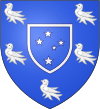 |
|


